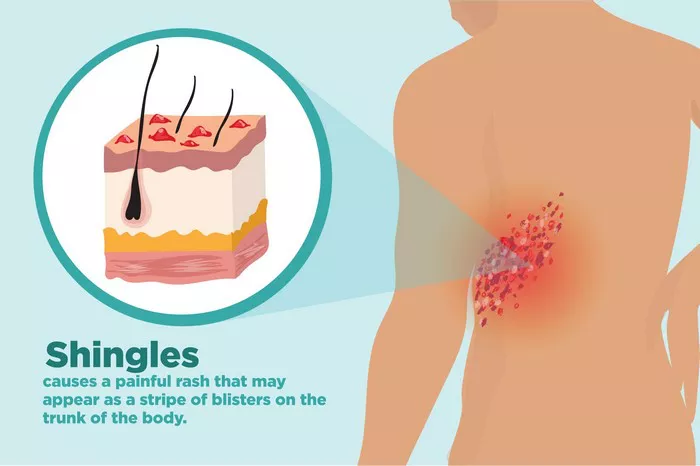Shingles, also known as herpes zoster, is a viral infection that can cause a painful rash. Understanding how long the rash lasts, as well as its associated symptoms, is essential for those affected. This article will discuss the duration of the shingles rash, its phases, and ways to manage symptoms effectively.
What is Shingles?
Shingles is caused by the varicella-zoster virus (VZV), the same virus that causes chickenpox. After recovering from chickenpox, the virus remains dormant in the nerve tissues. It can reactivate later in life, leading to shingles.
Symptoms of Shingles
The symptoms of shingles typically start a few days before the rash appears. They may include:
Pain: Often a burning or tingling sensation.
Sensitivity: The skin in the affected area may feel sensitive to touch.
Rash: A red rash that develops into blisters.
Fever: Mild fever can occur.
Headache: Some people experience headaches.
Fatigue: Feeling unusually tired is common.
How Long Does the Rash Last?
The duration of the shingles rash can vary significantly among individuals. Typically, the rash lasts about 7 to 10 days, but some cases can extend up to two to four weeks. Here’s a breakdown of the timeline:
Initial Symptoms
Prodromal Phase (1-5 Days): Before the rash appears, many experience pain, itching, or burning in the affected area. This phase can last from one to five days.
Rash Development
Rash Phase (7-10 Days): The rash usually starts as red patches and then develops into blisters. These blisters can break open and crust over. This phase usually lasts about 7 to 10 days.
Healing Phase
Crusting and Healing (2-4 Weeks): After the blisters crust over, the skin begins to heal. The crusts will eventually fall off, and the skin may take a few weeks to completely return to normal.
Total Duration
In total, from the onset of initial symptoms to complete healing, the process can take two to four weeks. However, some individuals may experience lingering pain or discomfort even after the rash has healed.
Phases of the Shingles Rash
Understanding the different phases of the shingles rash can provide insight into the healing process.
1. Pre-Rash Phase
Duration: 1-5 days.
Symptoms: Pain, tingling, or burning sensation in a specific area, often accompanied by sensitivity to touch.
2. Rash Phase
Day 1-3: Red patches appear.
Day 3-7: Blisters form on the red patches. These blisters may be filled with clear fluid.
3. Crusting Phase
Day 7-10: Blisters begin to break open, and the fluid dries, forming crusts.
Day 10-14: Crusts may start to fall off as the skin heals underneath.
4. Post-Herpetic Neuralgia (PHN)
Some individuals may experience PHN, where pain continues even after the rash has cleared. This pain can last for months or even years, affecting daily life.
Factors Affecting Duration
Several factors can influence how long the shingles rash lasts and its severity:
1. Age
Older adults often experience more severe cases of shingles. The immune system weakens with age, making it harder to fight off the virus.
2. Health Status
Individuals with weakened immune systems due to conditions such as HIV, cancer, or diabetes may have more prolonged and severe symptoms.
3. Treatment Promptness
Starting antiviral medication early can help reduce the duration and severity of the rash. Medications are most effective when taken within 72 hours of the rash’s appearance.
4. Stress Levels
Stress can weaken the immune system, potentially prolonging the duration of the rash. Managing stress through relaxation techniques may help.
Managing Symptoms
While shingles can be painful, several treatments can help manage symptoms effectively:
1. Antiviral Medications
Antiviral medications like acyclovir, valacyclovir, or famciclovir can shorten the duration of the rash and help alleviate pain. These medications are most effective when taken early in the course of the disease.
2. Pain Relief
Over-the-counter pain relievers such as acetaminophen or ibuprofen can help manage pain. In severe cases, doctors may prescribe stronger pain medication.
3. Cool Compresses
Applying cool, wet compresses to the rash can soothe irritation and reduce pain. Make sure not to apply ice directly to the skin.
4. Calamine Lotion
Calamine lotion can be applied to the rash to help relieve itching and discomfort.
5. Hydration
Staying well-hydrated is crucial during illness. Drink plenty of fluids to support overall health and recovery.
6. Rest
Rest is essential for recovery. Allow your body to heal by getting adequate sleep and reducing stress.
When to See a Doctor
If you suspect you have shingles, it is essential to see a doctor, especially if:
- You are experiencing severe pain.
- You have a weakened immune system.
- You are over 60 years old.
- The rash is near your eyes.
Potential Complications
While most cases of shingles resolve without serious complications, some individuals may experience:
Post-Herpetic Neuralgia (PHN): Chronic pain that persists after the rash has healed.
Vision Problems: If the rash affects the eye, it can lead to serious complications, including vision loss.
Bacterial Infections: Open blisters can become infected.
Conclusion
The painful rash of shingles can last from a week to several weeks, depending on various factors. Early treatment with antiviral medications can help shorten the duration and severity of the rash. Understanding the phases of shingles and how to manage symptoms effectively is crucial for those affected. If you suspect you have shingles, consult a healthcare professional to discuss treatment options and prevent complications. Taking care of your health and managing stress can also aid in recovery and reduce the risk of prolonged symptoms.
Related topics:



























